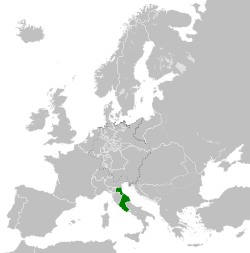Papal State
The Papal States, officially the State of the Church (Italian: Stato della Chiesa; Latin: Status Ecclesiae), were territories in the Italian Peninsula under the sovereign direct rule of the pope, from the 8th century until 1870. They were among the major states of Italy from roughly the 8th century until the Italian Peninsula was unified in 1861 by the Kingdom of Piedmont-Sardinia. At their zenith, they covered most of the modern Italian regions of Lazio (which includes Rome), Marche, Umbria and Romagna, and portions of Emilia. These holdings were considered to be a manifestation of the temporal power of the pope, as opposed to his ecclesiastical primacy.
By 1861, much of the Papal States' territory had been conquered by the Kingdom of Italy. Only Lazio, including Rome, remained under the Pope's temporal control. In 1870, the pope lost Lazio and Rome and had no physical territory at all, not even the Vatican. Italian Fascist leader Benito Mussolini ended the crisis between unified Italy and the Vatican by signing the Lateran Treaty, granting the Vatican City State sovereignty.
The Papal States were also known as the Papal State (although the plural is usually preferred, the singular is equally correct as the polity was more than a mere personal union). The territories were also referred to variously as the State(s) of the Church, the Pontifical States, the Ecclesiastical States, or the Roman States (Italian: Stato Pontificio, also Stato della Chiesa, Stati della Chiesa, Stati Pontifici, and Stato Ecclesiastico; Latin: Status Pontificius, also Dicio Pontificia).
...
Wikipedia




